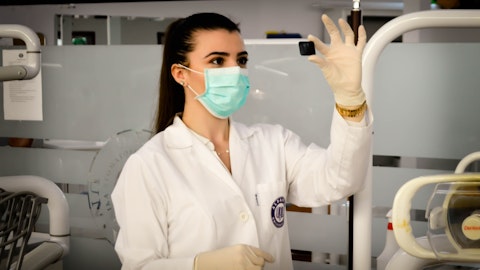Our company has to be to use our research dollars to develop medicines that ultimately get to market. And that’s what we’re very much focused on as well. So I’m very grateful for the NIBR team, or the Research I should say, Biomedical Research team. They’re doing a really good job with this new strategy and look forward to higher productivity from Research in the years to come. Next question, operator.
Operator: Thank you. Your next question comes from the line of Richard Vosser from JPMorgan. Please go ahead.
Richard Vosser: Hi. Thanks for taking my questions. One on Cosentyx, please. Could you talk about your submission on HS? There’s some discussion around — in the market around potential label changes with regard to [suicidal ideation] (ph) that I think one of your competitors has had placed on their IL-17A/F label. So just your thoughts on the submission timelines, how that’s going for HS, and also your thoughts on the emerging competition given that differential or different label that they have in terms of the warning. Thanks very much.
Vas Narasimhan: Yeah. Thanks, Richard. So for the recent approval of Cosentyx and IV, as well as our ongoing assessments of Cosentyx HS, we’ve had no indications of any changes to our safety labeling from what has already been established based on the 10 years of experience we have of Cosentyx in the market. Many hundreds of thousands of patients treated, many millions of patients — ultimate patient years that we have on the medicine. So we have no indication, and we’re in advanced discussions as well on the HS label right now for any labeling shifts. And that’s based on the data that we’ve consistently generated with respect to all safety signals and the clean profile that I think Cosentyx has demonstrated consistently over time.
Now, with respect to the competitiveness, given that Cosentyx does not have suicidal ideation. The need for liver enzyme monitoring, and very low rates of candidiasis, we believe that Cosentyx is positively differentiated versus the competitor product. Our strong reimbursement positions in the US as well as outside the US markets puts us in a very strong footing against any entrant, especially an entrant that has to overcome some safety liabilities. So I think we’re very well positioned in that regard. I would close by saying it’s important to note that IL-17A inhibitors are distinct from IL-17A/F inhibitors. Previously, as you all well know, Brodalumab in 20 — I think it was 2016, already has demonstrated that with the IL-17F inhibition, you can have some of these adverse consequences for that medicine.
So I think mechanistically it’s also important to treat these medicines fundamentally different, and that’s certainly what our position is as well. So, looking forward for Cosentyx, the focus is continuing to drive and get back to growth in the US behind the IV launch, as well as the upcoming HS approval. In Europe, maintain the strong position in PSA, AS, and psoriasis, but then also now drive the HS approval and then continue to complete the additional indications that we have ongoing to eventually reach the $7 billion peak sales that we’ve guided to.
Richard Vosser: Perfect. Thanks, Vas.
Vas Narasimhan: Next question, operator.
Operator: Thank you. Your next question comes from the line of Graham Parry from Bank of America. Please go ahead.
Graham Parry: Great. Thanks for taking my question. Just one for Harry. So, 3 bps raise this year. You’ve had positive NATALEE data, PSMAfore attack around C3 — IgAN I should say, since your last midterm guidance. So just wondering when is the right time to update that midterm guidance and how conservative that’s looking now? And does the PSMAfore OS data still pending actually push out when you might provide the market with an update on midterm? And then actually I’ll just do a Seamus and just follow up on that [macros] (ph) comparison as well. I think one of the issues that’s being raised in the market, Vas, is the fact that there were some issues around the conduct of VISION and the early dropout that we saw in that study around the PFS analysis.
So we didn’t even actually have that data on label. So if you — perhaps you can just compare and contrast the conduct of PSMAfore with VISION on the PFS endpoint and any concerns the FDA might have there would be useful. Thank you.
Vas Narasimhan: Thanks, Graham. Harry, on the guidance.
Harry Kirsch: I think those were four questions.
Vas Narasimhan: [indiscernible]
Harry Kirsch: Graham, thank you. So, I think overall, you nicely mentioned that we have taken up three times the guidance this year, absolutely on top line two times, now bottom line twice. I think in the end, of course, I don’t think I have done this in my 10 years, right, before. And it’s not on purpose ever, right? Each moment of time, of course, we try to give you a very balanced picture. You would say it’s, of course, a little bit prudent, yes, but not to this extent. And I think we have seen, I think Vas mentioned from the beginning, we have been positively surprised how well the whole — entire Novartis team, 76,000 colleagues, right, after the Sandoz spin, have responded to our Transformation for Growth program and the focus as a single innovative medicines company, of course, including some harder action, which in some countries, depending on union work and so on, took a bit longer of uncertainty, unfortunately.
But now that we are through that, the majority is still here or there, some things to implement. We have seen that this gives us more agility, faster decision-making and better impact in the market. That’s one thing. And on the bottom line, we do execute slightly ahead of plan. That helps, right? But of course, the most important in any pharma company is the top line growth that has been done so well. There’s a little bit of market expansion by probably 1 or 2 points. Actually, our global market has grown faster in the end versus initial estimates beginning of the year, but it doesn’t explain a 2 times top line upgrade. So it’s really the vast majority of that I contribute to our new leaner way of operating in the company. So from that standpoint, very confident that we continue to drive good growth.
There’s, of course, here or there leads, we divest, et cetera, all smaller points, but attractive growth. And then, Vas will give an outlook on the midterm growth potential of the company at the R&D Day.
Vas Narasimhan: Absolutely. So — and we continue to hold to the 4% and 40% margin, ’22 to ’27, and then we’ll update further in the R&D Day, Graham. Now, with respect to the VISION versus PSMAfore, it’s very different situations. The VISION study was partially inherited. There was no crossover allowed in the VISION study. So you had a high dropout rate, which was one of the things that we had to navigate with the FDA. But ultimately, the compelling data set, both for rPFS, which then was not included in the label because of the dropout issue, but OS, which was in the outstanding safety profile, we were able to bring the medicine to patients without going to an Advisory Committee. Contrast that to PSMAfore, where it was a very patient-friendly study, highly well-conducted, low dropout rate.
I think when you look at the conduct of the study, very highly — high integrity study that was conducted. And so, really a very different situation, and one where we really followed the guidance that FDA has given, which they encourage crossover for cancer studies, because they want patient-friendly studies supported by the patient community, that when a patient progresses they should be able to cross over onto the experimental therapy to achieve the full benefit. Now, what we have to navigate is on the one hand, FDA is encouraging us to do crossover, but then on the other hand, not letting us adjust for the crossover when we the OS analysis. So now we’re in — I think, companies across the industry are in a little bit of a conundrum as to how to manage that and we’re certainly planning on navigating that.
So VISION is fully in the label, PSMAfore, a really well-conducted study that we’re going to now take forward at the 75% information fraction. Next question, operator. Thanks, Graham.
Operator: Thank you. Your next question comes from the line of Mark Purcell from Morgan Stanley. Please go ahead.
Mark Purcell: Yeah. Thank you very much for taking my question. It’s a question on Kisqali and the outlook. My understanding is that from early next year there’s going to have to be prioritizations behind Ibrance, and Kisqali is in a pole position to take hold of that business with the [NCCN] (ph) guideline recommendations. So your NBRx share on a three-month rolling basis was 46% in the presentation. How high do you believe that could go, given that my understanding is about a third of physicians are still only prescribing Ibrance? And then just a housekeeping question, sticking on Kisqali. You’ve now hit 500 iDFS events. I was just wondering whether you could communicate if the upper confidence interval and overall survival has fallen below 1.0? It was 1.07 at the 46 iDFS events stage. And if not, your confidence in that reaching statistical significance? Thanks very much.




